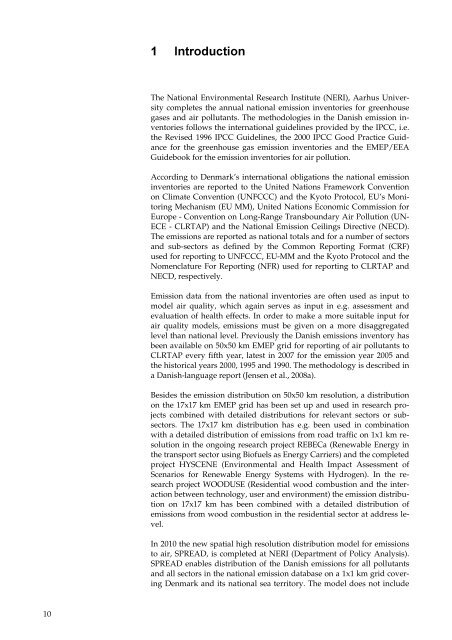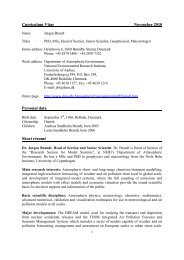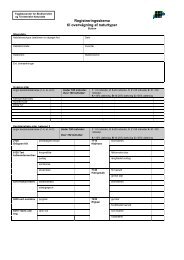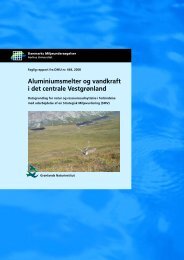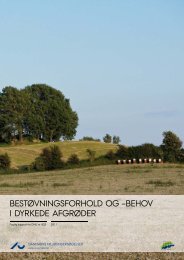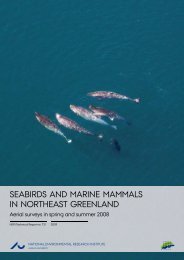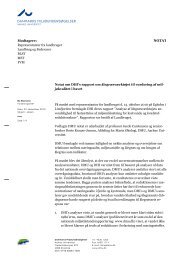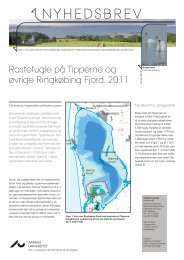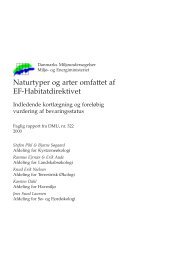Spatial distribution of emissions to air - the SPREAD model
Spatial distribution of emissions to air - the SPREAD model
Spatial distribution of emissions to air - the SPREAD model
Create successful ePaper yourself
Turn your PDF publications into a flip-book with our unique Google optimized e-Paper software.
10<br />
,QWURGXFWLRQ<br />
The National Environmental Research Institute (NERI), Aarhus University<br />
completes <strong>the</strong> annual national emission inven<strong>to</strong>ries for greenhouse<br />
gases and <strong>air</strong> pollutants. The methodologies in <strong>the</strong> Danish emission inven<strong>to</strong>ries<br />
follows <strong>the</strong> international guidelines provided by <strong>the</strong> IPCC, i.e.<br />
<strong>the</strong> Revised 1996 IPCC Guidelines, <strong>the</strong> 2000 IPCC Good Practice Guidance<br />
for <strong>the</strong> greenhouse gas emission inven<strong>to</strong>ries and <strong>the</strong> EMEP/EEA<br />
Guidebook for <strong>the</strong> emission inven<strong>to</strong>ries for <strong>air</strong> pollution.<br />
According <strong>to</strong> Denmark’s international obligations <strong>the</strong> national emission<br />
inven<strong>to</strong>ries are reported <strong>to</strong> <strong>the</strong> United Nations Framework Convention<br />
on Climate Convention (UNFCCC) and <strong>the</strong> Kyo<strong>to</strong> Pro<strong>to</strong>col, EU’s Moni<strong>to</strong>ring<br />
Mechanism (EU MM), United Nations Economic Commission for<br />
Europe - Convention on Long-Range Transboundary Air Pollution (UN-<br />
ECE - CLRTAP) and <strong>the</strong> National Emission Ceilings Directive (NECD).<br />
The <strong>emissions</strong> are reported as national <strong>to</strong>tals and for a number <strong>of</strong> sec<strong>to</strong>rs<br />
and sub-sec<strong>to</strong>rs as defined by <strong>the</strong> Common Reporting Format (CRF)<br />
used for reporting <strong>to</strong> UNFCCC, EU-MM and <strong>the</strong> Kyo<strong>to</strong> Pro<strong>to</strong>col and <strong>the</strong><br />
Nomenclature For Reporting (NFR) used for reporting <strong>to</strong> CLRTAP and<br />
NECD, respectively.<br />
Emission data from <strong>the</strong> national inven<strong>to</strong>ries are <strong>of</strong>ten used as input <strong>to</strong><br />
<strong>model</strong> <strong>air</strong> quality, which again serves as input in e.g. assessment and<br />
evaluation <strong>of</strong> health effects. In order <strong>to</strong> make a more suitable input for<br />
<strong>air</strong> quality <strong>model</strong>s, <strong>emissions</strong> must be given on a more disaggregated<br />
level than national level. Previously <strong>the</strong> Danish <strong>emissions</strong> inven<strong>to</strong>ry has<br />
been available on 50x50 km EMEP grid for reporting <strong>of</strong> <strong>air</strong> pollutants <strong>to</strong><br />
CLRTAP every fifth year, latest in 2007 for <strong>the</strong> emission year 2005 and<br />
<strong>the</strong> his<strong>to</strong>rical years 2000, 1995 and 1990. The methodology is described in<br />
a Danish-language report (Jensen et al., 2008a).<br />
Besides <strong>the</strong> emission <strong>distribution</strong> on 50x50 km resolution, a <strong>distribution</strong><br />
on <strong>the</strong> 17x17 km EMEP grid has been set up and used in research projects<br />
combined with detailed <strong>distribution</strong>s for relevant sec<strong>to</strong>rs or subsec<strong>to</strong>rs.<br />
The 17x17 km <strong>distribution</strong> has e.g. been used in combination<br />
with a detailed <strong>distribution</strong> <strong>of</strong> <strong>emissions</strong> from road traffic on 1x1 km resolution<br />
in <strong>the</strong> ongoing research project REBECa (Renewable Energy in<br />
<strong>the</strong> transport sec<strong>to</strong>r using Bi<strong>of</strong>uels as Energy Carriers) and <strong>the</strong> completed<br />
project HYSCENE (Environmental and Health Impact Assessment <strong>of</strong><br />
Scenarios for Renewable Energy Systems with Hydrogen). In <strong>the</strong> research<br />
project WOODUSE (Residential wood combustion and <strong>the</strong> interaction<br />
between technology, user and environment) <strong>the</strong> emission <strong>distribution</strong><br />
on 17x17 km has been combined with a detailed <strong>distribution</strong> <strong>of</strong><br />
<strong>emissions</strong> from wood combustion in <strong>the</strong> residential sec<strong>to</strong>r at address level.<br />
In 2010 <strong>the</strong> new spatial high resolution <strong>distribution</strong> <strong>model</strong> for <strong>emissions</strong><br />
<strong>to</strong> <strong>air</strong>, <strong>SPREAD</strong>, is completed at NERI (Department <strong>of</strong> Policy Analysis).<br />
<strong>SPREAD</strong> enables <strong>distribution</strong> <strong>of</strong> <strong>the</strong> Danish <strong>emissions</strong> for all pollutants<br />
and all sec<strong>to</strong>rs in <strong>the</strong> national emission database on a 1x1 km grid covering<br />
Denmark and its national sea terri<strong>to</strong>ry. The <strong>model</strong> does not include


